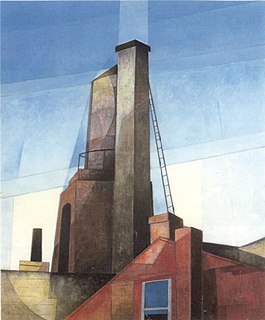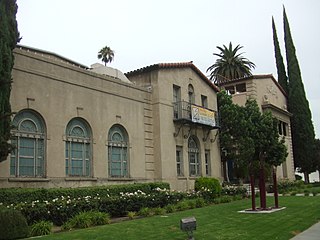
En plein air, or plein air painting, is the act of painting outdoors. This method contrasts with studio painting or academic rules that might create a predetermined look.

Thomas Gainsborough was an English portrait and landscape painter, draughtsman, and printmaker. Along with his rival Sir Joshua Reynolds, he is considered one of the most important British artists of the second half of the 18th century. He painted quickly, and the works of his maturity are characterised by a light palette and easy strokes. Despite being a prolific portrait painter, Gainsborough gained greater satisfaction from his landscapes. He is credited as the originator of the 18th-century British landscape school. Gainsborough was a founding member of the Royal Academy.

Precisionism was the first indigenous modern art movement in the United States and an early American contribution to the rise of Modernism. The Precisionist style, which first emerged after World War I and was at the height of its popularity during the 1920s and early 1930s, celebrated the new American landscape of skyscrapers, bridges, and factories in a form that has also been called "Cubist-Realism." The term "Precisionism" was first coined in the mid-1920s, possibly by Museum of Modern Art director Alfred H. Barr although according to Amy Dempsey the term "Precisionism" was coined by Charles Sheeler. Painters working in this style were also known as the "Immaculates," which was the more commonly used term at the time. The stiffness of both art-historical labels suggests the difficulties contemporary critics had in attempting to characterize these artists.

The Hammer Museum, which is affiliated with the University of California, Los Angeles, is an art museum and cultural center known for its artist-centric and progressive array of exhibitions and public programs. Founded in 1990 by the entrepreneur-industrialist Armand Hammer to house his personal art collection, the museum has since expanded its scope to become "the hippest and most culturally relevant institution in town." Particularly important among the museum's critically acclaimed exhibitions are presentations of both historically over-looked and emerging contemporary artists. The Hammer Museum also hosts over 300 programs throughout the year, from lectures, symposia, and readings to concerts and film screenings. As of February 2014, the museum's collections, exhibitions, and programs are completely free to all visitors.
The year 1962 in art involved some significant events and new works.

Landscape painting, also known as landscape art, is the depiction of landscapes in art—natural scenery such as mountains, valleys, trees, rivers, and forests, especially where the main subject is a wide view—with its elements arranged into a coherent composition. In other works, landscape backgrounds for figures can still form an important part of the work. Sky is almost always included in the view, and weather is often an element of the composition. Detailed landscapes as a distinct subject are not found in all artistic traditions, and develop when there is already a sophisticated tradition of representing other subjects.

Marion Kavanaugh Wachtel was a plein air painter in watercolors and oils that lived and worked with her artist husband Elmer Wachtel in the Arroyo Seco near Pasadena, California, in the early 20th century.

The Laguna Art Museum (LAM) is a museum located in Laguna Beach, California, on Pacific Coast Highway. LAM exclusively features California art and is the oldest cultural institution in the area. It has been known as the Laguna Beach Art Association, as well as the Laguna Beach Museum of Art.
Elizabeth O'Neill Verner was an artist, author, lecturer, and preservationist who was one of the leaders of the Charleston Renaissance. She has been called "the best-known woman artist of South Carolina of the twentieth century."
The California Art Club (CAC) is one of the oldest and most active arts organizations in California. Founded in December 1909, it celebrated its centennial in 2009 and into the spring of 2010. The California Art Club originally evolved out of The Painters Club of Los Angeles, a short-lived group that lasted from 1906–09. The new organization was more inclusive, as it accepted women, sculptors and out of state artists. Most of the major early California painters belonged to the CAC, including Franz Bischoff (1864–1929), Carl Oscar Borg (1879–1947), Edgar Payne (1883–1947), Julia Bracken Wendt (1868–1942), and William Wendt (1865–1946). As the members of the first generation of California Plein-Air Painters aged and died, the membership was filled by younger professional painters, including Millard Sheets (1907–1989), Mabel Alvarez (1891–1985), Emil Kosa, Jr. (1903–1968), and watercolorist Rex Brandt (1914–2000), along with amateur painters and commercial artists. Other notable members include Sir Winston Churchill (1874–1965), Dean Cornwell (1892–1960), Nicolai Fechin (1881–1955), Sam Hyde Harris (1889–1977), Alfredo Ramos Martinez (1872–1946), and Richard Neutra (1892–1970).

Sterling Ruby is an American artist who works in a large variety of media including ceramics, painting, drawing, collage, sculpture, video, and textiles. Often, his work is presented in large and densely packed installations. The artist has cited a diverse range of sources and influences including aberrant psychologies, urban gangs and graffiti, hip-hop culture, craft, punk, masculinity, violence, public art, prisons, globalization, American domination and decline, waste and consumption. In opposition to the minimalist artistic tradition and influenced by the ubiquity of urban graffiti, the artist's works often appear scratched, defaced, camouflaged, dirty, or splattered. Proclaimed as one of the most interesting artists to emerge this century by New York Times art critic Roberta Smith, Ruby's work examines the psychological space where individual expression confronts social constraint. Sterling Ruby currently lives and works in Los Angeles. His studio is located in Vernon, south of downtown Los Angeles.
Julie Heffernan is an American painter whose work has been described by the writer Rebecca Solnit as "a new kind of history painting" and by The New Yorker as "ironic rococo surrealism with a social-satirical twist." Heffernan has been a Professor of Fine Arts at Montclair State University in Upper Montclair, New Jersey since 1997. She currently lives in New York, New York.
Peter Seitz Adams is an American artist. His body of work focuses on landscapes and seascapes created en plein air in oil or pastel as well as enigmatic figure and still-life paintings. He is noted for his colorful, high-key palette and broad brushwork. Adams has held numerous solo and group exhibitions in galleries and museums, including throughout California, the Western United States, and on the East Coast in Philadelphia, Vermont, and New York. Adams is the longest serving President of the California Art Club and has served on its board of directors in Pasadena, California from 1993 to 2018. He is also a writer on subjects relating to historic artists for the California Art Club Newsletter, as well as for a number of the organization's exhibition catalogs.

The terms California Impressionism and California Plein-Air Painting describe the large movement of 20th century California artists who worked out of doors, directly from nature in California, United States. Their work became popular in the San Francisco Bay Area and Southern California in the first three decades after the turn of the 20th century. Considered to be a regional variation on American Impressionism, the painters of the California Plein-Air School are also described as California Impressionists; the terms are used interchangeably.
California Tonalism was art movement that existed in California from circa 1890 to 1920. Tonalist are usually intimate works, painted with a limited palette. Tonalist paintings are softly expressive, suggestive rather than detailed, often depicting the landscape at twilight or evening, when there is an absence of contrast. Tonalist paintings could also be figurative, but in them, the figure was usually out of doors or in an interior in a low-key setting with little detail.

William (Kross) Greiner in New Orleans, Louisiana is an American photographer and painter, now living in Fort Worth, TX.

Annie Lyle Harmon was a Californian plein-air artist known especially for her paintings of trees. A student of leading landscape artist William Keith (1838–1911), Harmon, along with several other artists, was a fixture in Keith’s studio for many years.
Mary Corse is an American artist who lives and works in Topanga, California. Fascinated with perceptual phenomena and the idea that light itself can serve as both subject and material in art, Corse's practice can be seen as existing at an crossroads between American Abstract Expressionism and American Minimalism. She is often associated with the male-dominated Light and Space art movement of the 1960s, although her role has only been fully recognized in recent years. She is best known for her experimentation with radiant surfaces in minimalist painting, incorporating materials that reflect light such as glass microspheres. Corse initially attended University of California, Santa Barbara starting in 1963. She later moved on to study at Chouinard Art Institute, earning her B.F.A. in 1968.

Natalia Anciso is an American Chicana-Tejana contemporary artist and educator. Her artwork focuses primarily on issues involving Identity, especially as it pertains to her experiences growing up along the U.S.-Mexico Border, via visual art and installation art. Her more recent work covers topics related to education, human rights, and social justice, which is informed by her experience as an urban educator in the San Francisco Bay Area. She is a native of the Rio Grande Valley of South Texas and currently lives and works in Oakland, California.
Charlotte Nalle Eyerman is an American museum director and curator and expert in 19th century French art. She was appointed Director and Chief Curator of the JPMorgan Chase art collection in 2017. She is a member of the board of trustees at Accountability Lab. Eyerman has also served as Director and Chief Executive Officer of the Monterey Museum of Art (2010–13), and as Director of the Gagosian Gallery, Beverly Hills.
















